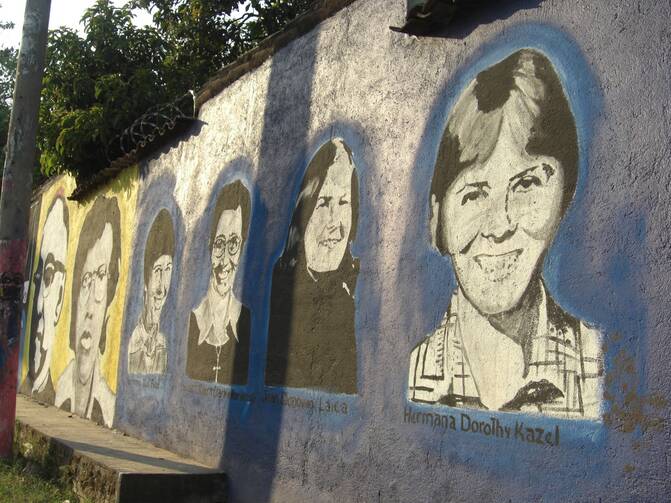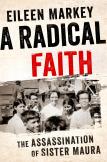Remembering martyrs for their humanity, as well as their faith
Overused in contemporary parlance, the word martyr has perhaps lost its power to move us. It is either rendered ridiculous through misapplication to minor situations or seems so sublime that our paltry mortal minds cannot grasp its meaning. In her book A Radical Faith: The Assassination of Sister Maura, the investigative journalist Eileen Markey sets about reclaiming one such martyr from the remoteness of the pedestal: Maura Clarke, who along with two other nuns, Dorothy Kazel and Ita Ford, and a laywoman, Jean Donovan, was murdered by National Guard troops in El Salvador in early December 1980.
A Radical Faith is, as its subtitle suggests, framed by a grim black border of death. “The grave was fresh,” the book begins. The final chapter opens: “The death squads came in the night.” Yet long after the last page is turned, Markey’s story resounds in the reader’s heart as a deeply felt and profoundly stirring affirmation of life, of a singular life. She succeeds brilliantly at transforming the martyr Maura, symbol of ultimate Christian commitment, into a recognizable human being—incarnate, immediate and arresting in her individuality. And in doing so, Markey opens up all sorts of possibilities for us. Because if Maura, the martyr, is like us—imperfect, thirsty for God, responding to the challenges of her time and place as best she could—then perhaps we can be like Maura.
The book is well-written, well-paced and well-researched. Markey draws on a wide variety of sources to craft her story: government documents, reports from human rights organizations, parish journals, newspaper articles, books, journals, letters and interviews with family members, Maryknoll sisters and countless people in Nicaragua and El Salvador whose lives Maura Clarke touched. There are nearly 40 pages of footnotes at the book’s end. While in other cases I find it irritating to have to flip back and forth between text and endnotes, here the burden was light. Whenever Markey presented some granular detail—about an article of clothing, a personal foible, a conversation—I wondered, “How did she learn that?” and turned eagerly to the relevant footnote.
The forensic work, then, is sound, bolstered by dogged research and clear reporting. But Markey’s account is neither dry nor dehumanizing, perhaps because it is animated by a compassionate curiosity: “How did this woman get here?” She recounts Maura’s early years growing up on the narrow peninsula of the Rockaways at Long Island’s western edge—a lovely, lively, generous soul who yearned to stretch beyond the bounds of childhood geography to make a difference in the world. She depicts Maura’s life in the Maryknoll novitiate, a rigid but spiritually redolent pre-Vatican-II environment, where the young nun developed a deep and enriching prayer life that would serve her well in bleak and turbulent circumstances. She follows Maura’s trajectory from her first assignment in the wilds of the Bronx (of which Markey amusingly notes, “This felt a little like being called to the junior varsity team”) to her many years in Nicaragua, to the final searing sojourn in El Salvador.
Markey’s range is telescopic and impressive. She sensitively portrays some of the psychological underpinnings of Maura’s personality—her need for approval, her aversion to conflict—as well as the joy Maura took in participating alongside the lives of the people. At the same time, Markey trains her attention, and ours, on the broader backdrop against which Maura was living out her call. Whether it is a concise summary of 20th-century U.S. policy toward Nicaragua, a consideration of the Irish Revolution or an account of the changes wrought by the Second Vatican Council, Markey grasps the larger context and aptly demonstrates its relevance, switching gears easily among the religious, the political and the personal.
It was, perhaps, the confluence of these three that led to the death of this loving and remarkably generous woman. Maura’s years in Central America coincided with a period of sweeping transformation in the church’s understanding of its role in the world. Unsurprisingly, the Maryknoll nuns’ perspective on their work evolved accordingly. Originally focused on teaching skills that would allow poor Nicaraguans to improve their lives, Maura’s sense of purpose became more radically identified with the poor and infused with a desire to change the structural inequities that created and perpetuated poverty. Yet her posture was not political, but spiritual: The work of the Christian is to build the world Christ ushered in, by affirming the dignity and basic human rights of every person. Maura’s approach to the people of Nicaragua and El Salvador was one of complete, transcendent generosity and love.
Like tens of thousands of Salvadorans who ended up tortured, mutilated or killed by the government-backed (and in many cases, U.S.-trained) death squads, Maura might appear to have been a loser in the fight for human dignity. Not so. As a young girl, during evening strolls with her father on the boardwalk of the Rockaways, Maura was taught that people who stand up for the underdogs and oppose the principalities and powers often lose their battles, and even their lives. But their legacy, as Markey summarizes, is “immortality in memory.” In this sense, Maura’s legacy is manifold.
Some years after the deaths of of the four churchwomen, Ita Ford’s nephew, Bill Ford III, went to El Salvador to carry on his aunt’s work. Plagued by illness, he persisted nonetheless, until a Salvadoran nun said to him, “You do not have to be in El Salvador to continue your aunt’s mission.” Bill Ford returned to the United States. With tenacity, hard work and the help of a dedicated group of recruits, in 2004 he finally realized the dream of opening Cristo Rey New York High School, a college preparatory school whose students—75 percent of whom are Latino—engage in a rigorous curriculum and work at entry-level business jobs. These students, who honor Ita Ford, Maura Clarke and their two colleagues as the spiritual founders of Cristo Rey New York, are rising to a better life on the wings of dedication and generosity of heart typified by these four women.
The British mystic Evelyn Underhill wrote, “We believe that the tendency to give, to share, to cherish, is the mainspring of the universe...and reveals the Nature of God: and therefore that when we are most generous we are most living and most real.” Thanks to Eileen Markey’s marvelous book, Maura Clarke lives on through her soul’s wide generosity, challenging us to animate the world around us with a similar spirit of self-giving.
This article also appeared in print, under the headline “Portrait of a Martyr,” in the January 2, 2017, issue.









